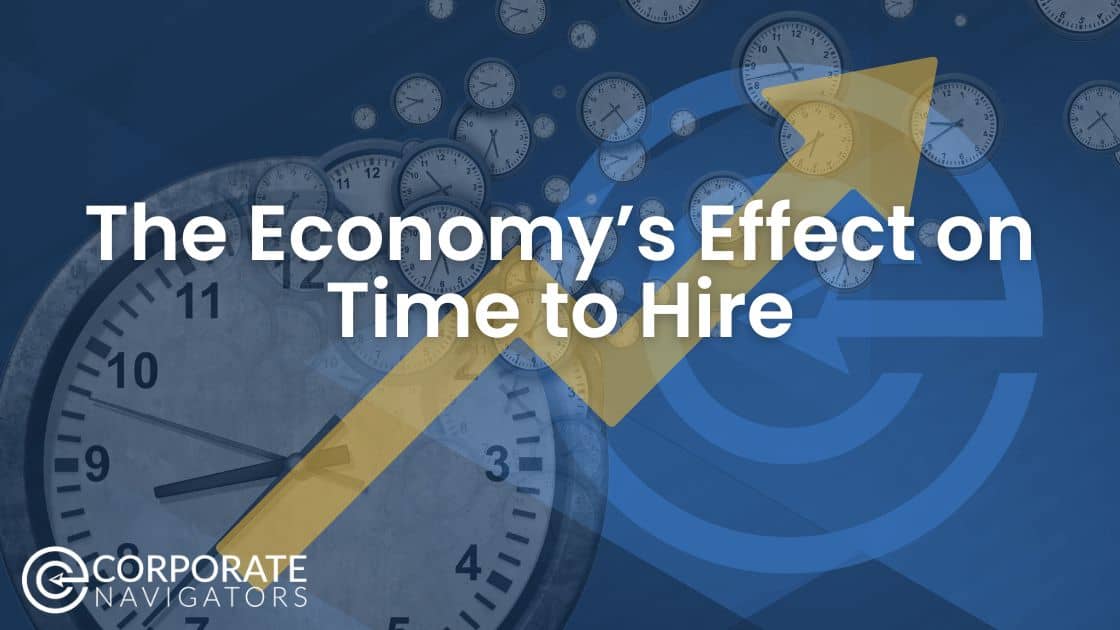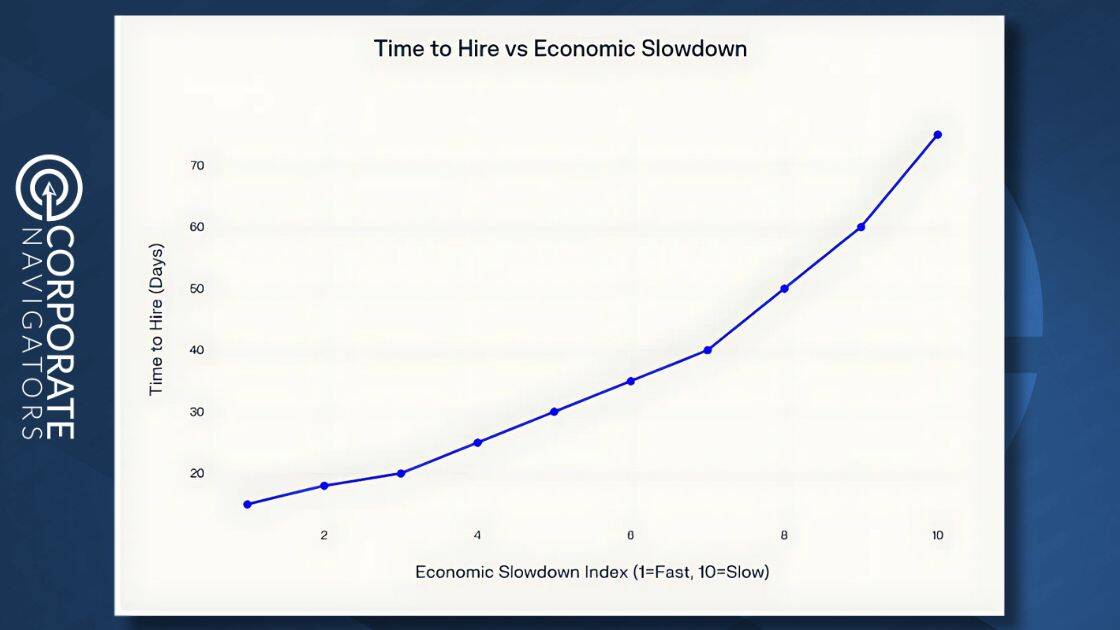
Table of Contents: Time to Hire
How the Economy Influences Time to Hire
The average time to hire in the U.S. has been holding steady after a post-pandemic increase. In a recent study that uses data from Indeed on job creation and hire dates*, the average time to hire in the U.S. fell sharply by 23% from February 2020 to August 2022. It then began rising again and is now nearly back to pre-pandemic levels by Q2 of 2025.
This pattern suggests that labor market tightness and broader macroeconomic factors are key drivers of changes in hiring timelines. Knowing key data like this can assist hiring managers and recruiters as they navigate the recruitment process and the complexities of the labor market.
What is Time to Hire?
In the recruiting world, “time to hire” signifies the days between a job posting and the first hire. In other words, it’s how many days pass between when a candidate applies for a job and when that same candidate accepts a job offer. This important metric tracks the speed of your hiring process from the moment a qualified applicant enters your recruitment funnel until they agree to join your company.
Keeping track of your average time to hire (also known as time to fill) is important because it helps organizations understand how efficiently they move candidates through the hiring process and can highlight areas where delays or bottlenecks might be occurring. A shorter time to hire usually means a more efficient and candidate-friendly process, while a longer time to hire may signal issues that could cause you to lose out on top talent
So What Happened?
After the pandemic, job openings surged and employers struggled to find candidates, creating a job seeker’s market. Surprisingly, this led to faster hiring, not slower. Employers moved quickly to secure talent, sometimes broadening their candidate pool to fill roles more urgently. In addition, between 2021-2022, high voluntary quits (aka the “great resignation”) created urgent hiring needs, leading to shorter time to hire.
However, as the labor market cooled and quits declined from their peak, the urgency faded, and time to hire increased, reflecting a shift from urgent backfills to more deliberate, growth-driven hiring.
What we can gather from this data is that there is a negative correlation between time to hire and the U.S. quits rate. When more workers quit (as during the “Great Resignation”), employers fill roles faster, likely because these are urgent backfills for existing positions. We can also see that time to hire is increases with the labor force participation rate. When more people are in the workforce, it tends to take longer to fill jobs than when there are vacancies. And, in a slower economy, more people hold onto their jobs.
While more econometric study is needed to confirm these findings, the numbers do give a strong case to
Time to Hire vs Economic Slowdown

This graph demonstrates how the time to hire increases as the economy slows down. The x-axis represents the “Economic Slowdown Index” (where 1 means a fast, strong economy and 10 means a slow, weak economy), and the y-axis shows the “Time to Hire” in days. As the index increases, indicating a slower economy, the time required to fill positions rises sharply, from about 15 days in a fast economy to 75 days in a slow one.
This trend reflects real-world hiring dynamics during economic downturns:
- Increased Application Volume: During recessions or slowdowns, more people are seeking jobs due to layoffs and hiring freezes, resulting in a larger pool of applicants for each opening. While this gives employers more choice, it also means recruiters spend more time reviewing resumes, conducting interviews, and making decisions, which lengthens the hiring process.
- Cautious Hiring: Companies tend to be more conservative with hiring during uncertain times, often implementing additional approval steps or scrutinizing candidates more closely to ensure the best fit. This added caution further increases the time to hire.
- Shifts in Recruitment Priorities: The focus often shifts from rapid hiring to more strategic, careful selection, which can be beneficial for long-term team building but slows down the process in the short term.
It’s important to note that the numbers are illustrative and based on projections if the economy continues to slow down. The current average time to fill is still around 44 days. This graph merely poses an example that as economic conditions worsen (moving from left to right on the graph), the hiring process can become slower and more deliberate, resulting in a significant increase in the average time it takes to fill positions.
How to Shorten Time to Hire in 2025
To decrease the number of days spent in the hiring process, there are several things employers can do right now to maximize their odds of securing top talent without a long wait. Every company’s needs are different, so take these tips and see which ones apply to your situation.
Improve your brand image.
No matter how great your recruitment strategy is, if you’re not a good place to work, candidates will flee a company with a bad reputation. Work on your brand and create a positive image and culture where candidates would want to make a long-term position theirs.
Create a great candidate experience.
Nobody likes to wait days to hear feedback about their application or job interview, so making the candidate’s experience with you positive will have lasting returns, whether they join you or not. Overall, a streamlined candidate journey in which candidates get timely feedback and friendly interactions leave a lasting, positive impact that not only keeps good candidates in consideration for future opportunities, but it also is a free way to spread positive news about your company.
After all, “Hey, I didn’t get the job but their HR was really nice and even asked if they could keep in touch for future roles,” sounds a lot better than, “Yikes, they never called me back and an AI chatbot sent me a generic rejection email.”
Preemptively build a Candidate Pipeline.
Having a list of people you can call who are known to be qualified for the role and interested in working with you is certainly a strong advantage in shortening the time to hire. It cuts down the wait time in identifying candidates, screening their backgrounds, and building relationships with them. Basically, you’re skipping the line with this method as you go right to the interview and onboarding stage. To build a candidate pipeline, ask us about our candidate sourcing service.
Utilize an applicant tracking system (ATS).
Staying organized with your applicants and potential candidates can improve your time to hire metric. An applicant tracking system can keep tabs on all your candidates in one place. Knowing who is further along the candidate journey, having instant notes on each contact, and other important details, you can navigate the candidate search in a more efficient way, which allows you to pursue the warm leads while not spending too much time on cold leads.
The Economy and Time To Hire
After careful examination of trends, the numbers show that time to hire fell sharply during the tightest post-pandemic labor market as employers moved fast to secure talent, especially to replace workers who quit.
But as the market cooled, hiring timelines lengthened, reflecting less urgency and a shift in the reasons for hiring. These trends highlight how time to hire can reveal underlying shifts in employer behavior and broader economic conditions, meanwhile helping employers with any decision-making regarding future hiring needs.
*with adjustments for seasonality and outliers


